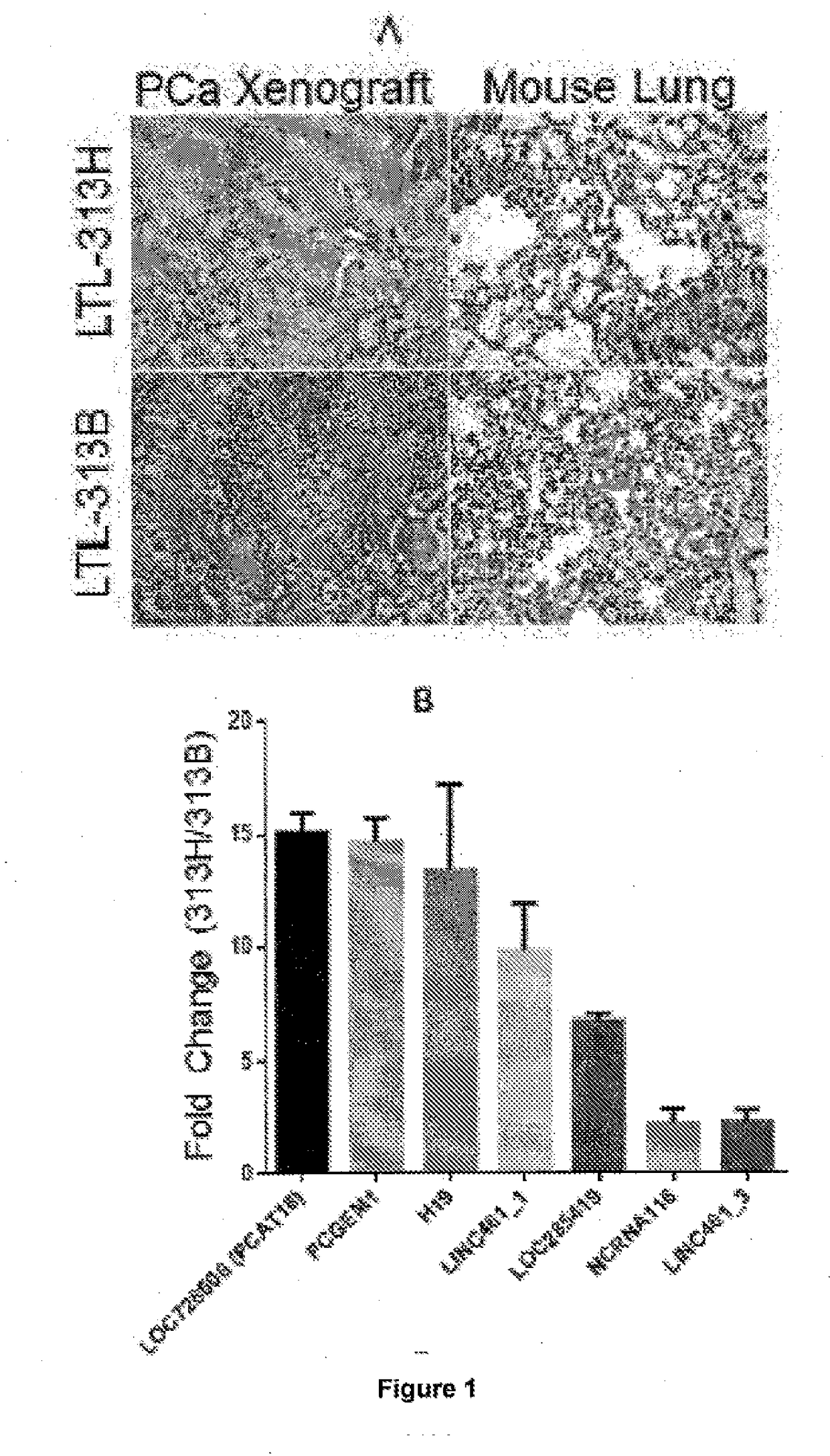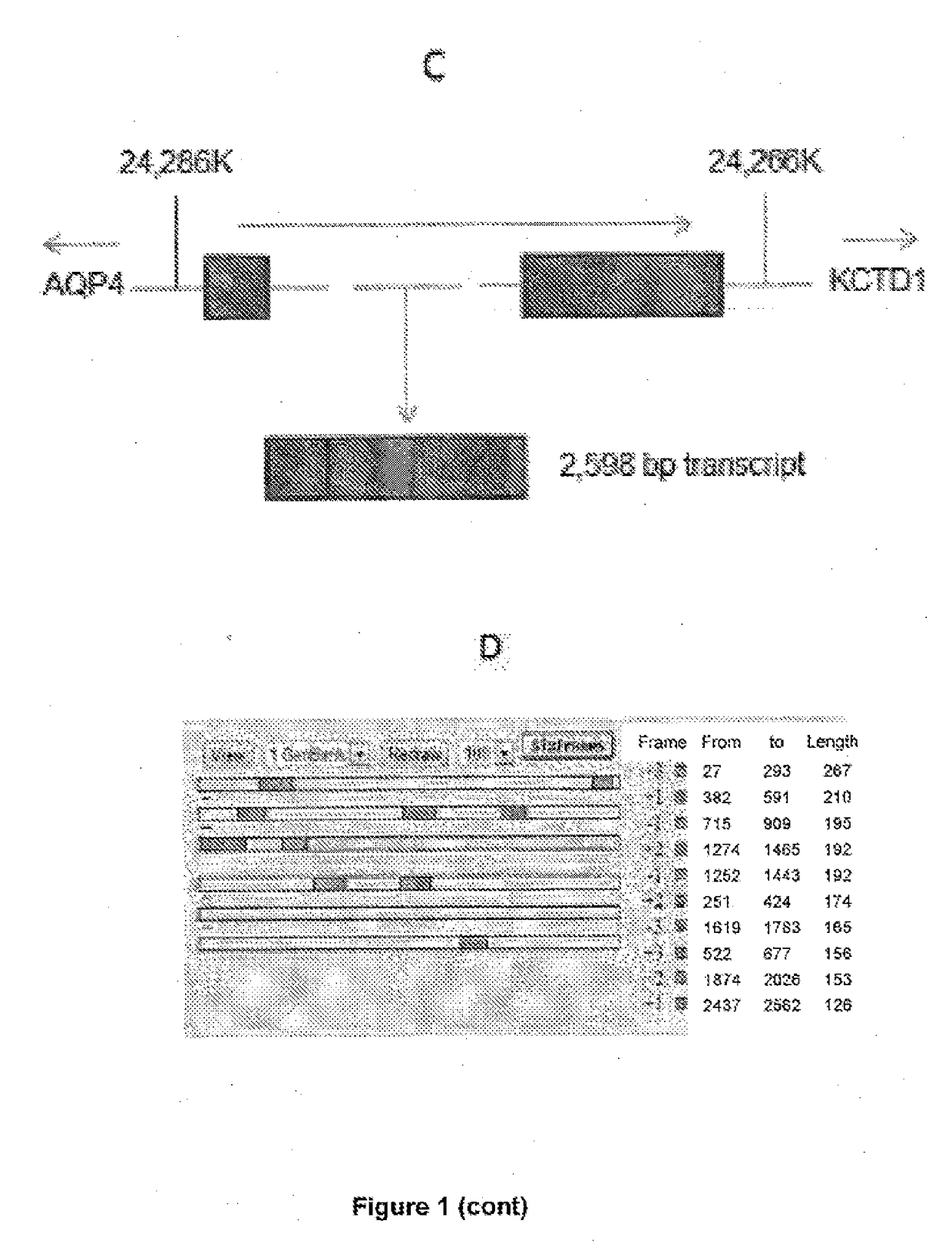Methods and uses for diagnosis and treatment of prostate cancer
- Summary
- Abstract
- Description
- Claims
- Application Information
AI Technical Summary
Benefits of technology
Problems solved by technology
Method used
Image
Examples
example 1
ation of PCAT18
[0173]The identification of novel biomarkers and therapeutic targets for mCRPC has been hampered by the lack of suitable models that accurately reflect the clinical reality. This hurdle has been overcome by the generation of xenograft models developed from primary patient samples. In the present application, 2 PCa xenograft lines were exploited: LTL-313B and LTL-313H. Both models were derived from PCa biopsies of the same patient, yet they display a strikingly different phenotype. LTL-313B cells (non-metastatic) showed little local invasion and no distant metastasis while LTL-313H xenografts (metastatic) showed invasion into the mouse host kidney and distant metastases were detectable in the hosts' lungs 3 months after engraftment (FIG. 1A).
[0174]RNA Sequencing was performed on paired metastatic / non-metastatic PCa orthotopic xenografts derived from clinical specimens. The most differentially expressed lncRNA was further analyzed in clinical samples and publically avai...
example 2
n Analysis of JUPITER (Also Known as PCAT18)
[0180]The expression of LOC728606 was investigated in publically available databases, for example, the Oncomine™ (FIG. 2A) and cBio (FIG. 28) databases. LOC728606 expression profiles were mined on Oncomine and Gene Expression Omnibus (GEO) databases, which include large collections of microarray data from human samples. LOC728606 is significantly up-regulated in PCa vs, normal tissue in both the Oncomine™ (FIG. 2A) and cBio (FIG. 28) databases. The data from the Oncomine™ analysis is summarized below in Table 7.
TABLE 7Summary of all Oncomine ™ Outputs for LOC728606 in PCa, with pvalue >0.01 and / or fold change StudyComparisonP valueFold ChangeSamplesArredouaniPCa vs. normal0.0432.021prostateArredouaniERG rearrangement0.0752.013vs. no rearrangmentBittnerPCa-smoker vs. non-0.503−1.046smokerBittnerAcinar PCa-Grade 20.750−1.8010vs. grade 3BittnerPCa-Grade 2 / 3 vs.0.761N.A.46grade 3BittnerPCa-Stage 2 / 3 vs.0.750N.A.43stage 4BittnerAcinar PCa-smoke...
example 3
ation of Transcripts Associated with JUPITER
[0185]Based on its expression profile, it was hypothesized that JUPITER might contribute to PCa clinical characteristics and interact with known oncogenic pathways. To this end, significance analysis of microarray data (SAM) was used to identify PCAT18-associated to transcripts. A dataset collecting RNA sequencing data and clinical Information on 131 PCa samples and 29 normal prostate tissues was exploited for this purposes. Analysis of this large dataset further confirmed that PCAT18 is significantly (p<0.001) up-regulated in PCa vs normal prostate (data not shown). SAM revealed 402 genes positively and significantly associated with PCAT18 / JUPITER expression in PCa samples, as shown in Table 8 below. One or more than one of the genes listed in Table 8 may be used in combination with PCAT18 in order to diagnose or treat prostate cancer using the methods as described herein.
TABLE 8PCAT18-associated expression signature.ACACAacetyl-CoA carbo...
PUM
| Property | Measurement | Unit |
|---|---|---|
| Antisense | aaaaa | aaaaa |
| Level | aaaaa | aaaaa |
Abstract
Description
Claims
Application Information
 Login to View More
Login to View More - R&D
- Intellectual Property
- Life Sciences
- Materials
- Tech Scout
- Unparalleled Data Quality
- Higher Quality Content
- 60% Fewer Hallucinations
Browse by: Latest US Patents, China's latest patents, Technical Efficacy Thesaurus, Application Domain, Technology Topic, Popular Technical Reports.
© 2025 PatSnap. All rights reserved.Legal|Privacy policy|Modern Slavery Act Transparency Statement|Sitemap|About US| Contact US: help@patsnap.com



